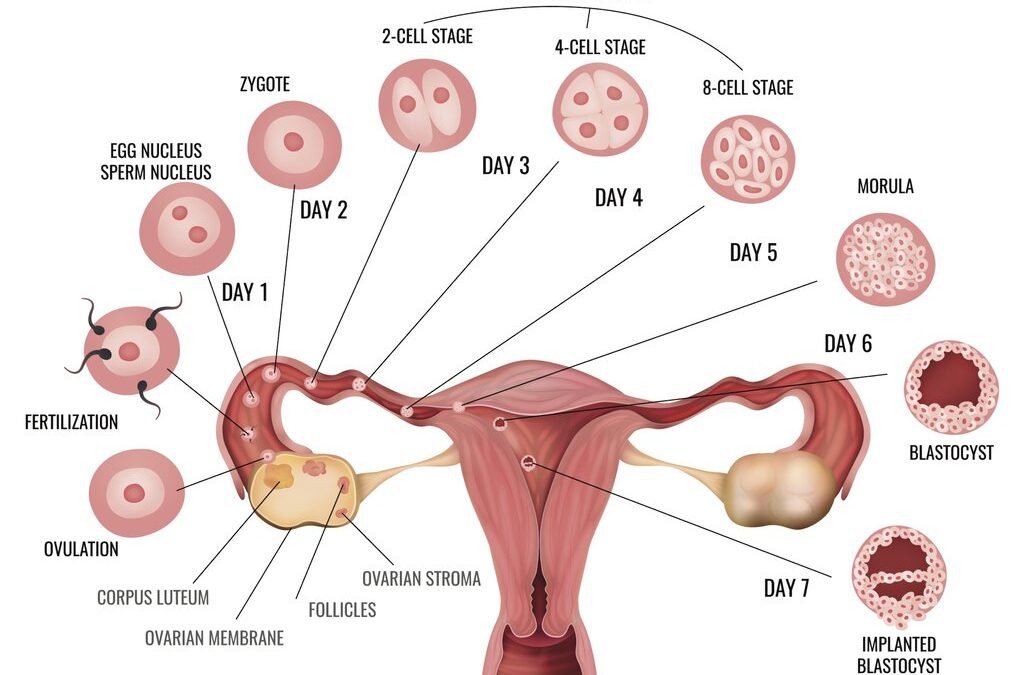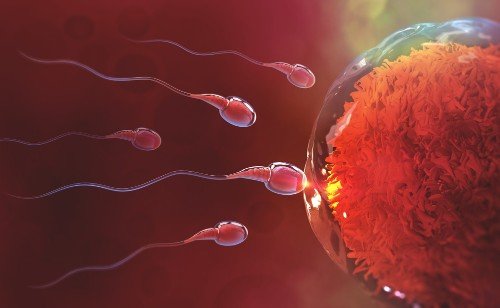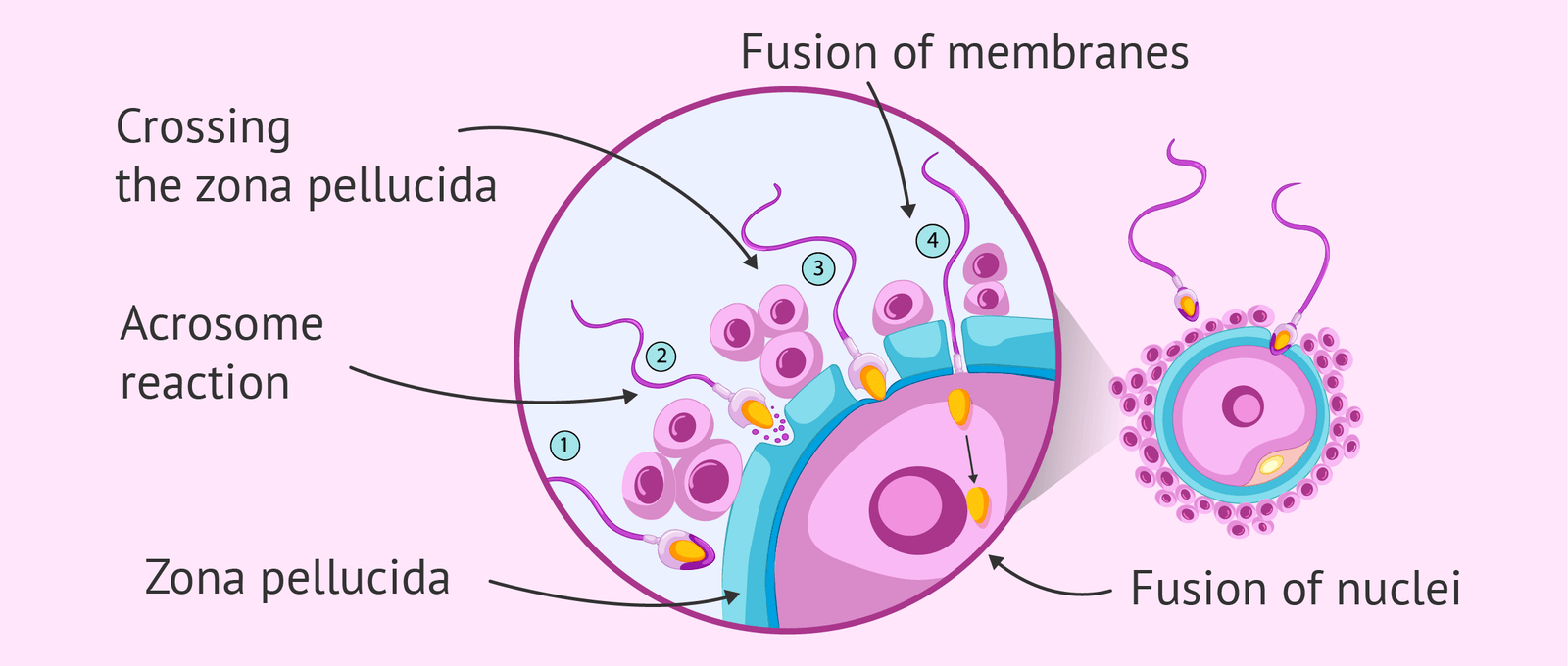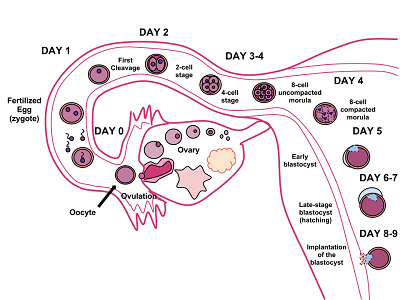Fertilization and implantation – This course is designed to understand the care of pregnant women and newborn: antenatal, intra-natal and postnatal; breast feeding, family planning, newborn care and ethical issues, The aim of the course is to acquire knowledge and develop competencies regarding midwifery, complicated labour and newborn care including family planning.
Fertilization and implantation
Definition of Ovulation:
Ovulation means “to produce and discharge eggs from an ovary or ovarian follicle”.
or
Ovulation is the release of an egg from one of a woman’s ovaries. After the egg is released, it travels down the fallopian tube, where fertilization by a sperm cell may occur.
or
The release of the ripe egg (ovum) from the ovary. The egg is released when the cavity surrounding it (the follicle) breaks open in response to a hormonal signal.

Figure: Ovulation
Definition of Fertilization:
The process of combining the male gamete, or sperm, with the female gamete, or ovum. The product of fertilization is a cell called a zygote.
or
Fertilization is the process by which male and female germ cells fuse to form a zygote.

Figure: fertilization.
Process of fertilization/ phases of fertilization:
1. Transport of spermatozoa: 200-300 million of spermatozoa deposit in the female genital tract. Among them 300-500 reach in site of fertilization. Of them only one is needed for fertilization. Other helps in barrier penetration.
2. Barrier penetration:
i. Penetration of corona radiate: The corona radiata cells are disperse by the combined action of sperm (acrosomal reaction) & sutbal mucosal enzyme.
ii. Penetration of pellucida: It is penetrated by the sperm with the aid of enzyme (trypsin like substance, acrosin) released from the inner acrosomal membrane. After coming of the 1st sperm in contact with the oocyte surface, zona reaction occurs to prevent further entry of sperm.
iii. Fusion of oocyte and sperm cell membranes: When the sperm touches the oocyte cell membrane, the two plasma membranes fuse. Leaving the plasma membrane behind, the head & tail of sperm enter the cytoplasm of the oocyte.

Figure: Process of fertilization
3. Pronucleus formation: Now the oocyte completes its 2nd meiotic devision. The daughter cell which receives more cytoplasm forms the female pronucleus. In case of male, nucleus form the head of the sperm becomes, swollen to form male pronucleus.
4. DNA replication: Replication of DNA occurs in both pronuclei during their formation.
5. Mitotic division: The pronuclei meet their nuclear membranes disappear and chromosomes are arranged in distinct manner for the normal mitotic division.
Factors upon which fertilization depends:
1. Time of ovulation.
2. Time by which sperm reaches the uterine tube
Factors for successful fertilization:
1. Sex cells must be matured.
2. Sex cells must have haploid chromosomes.
3. Capacitation must occur.
4. Union of two different sex cells must their viability.
Results of fertilization:
1. Restoration of diploid number of chromosome.
2. Determination of sex of new individual
3. Initiation of cleavage
4. Completion of second meiotic division of female gamete.
Various steps/stages in fertilization:
1. Movement of the sperm towards the egg.
2. Capacitation and contact.
3. Penetration of sperm into ovum.
4. Cortical reaction.
5. Activation of the ovum.
6. Fusion of male and female pronuclei (amphimixis).
1. Movement of the sperm towards the egg: This is the first step which brings the sperm in physical contact with the ovum. As the male and female gametes are produced in different individuals, there are various mechanisms to bring them nearer. The initial attraction of the sperms towards the egg is supposed to be chmotactic. The sperms swim towards the egg collides with it. Usually several sperms attach themselves to the egg.
In individuals with external fertilization large number of eggs and sperms are released outside so that they have a favourable chance of meeting with each other. In individuals with internal fertilization the sperms are discharged into the genital tract of the females by the male individual. From here the sperms move upward and reach the egg present in the uterus.
2. Capacitation and contact: When a large number of sperms approach the egg for contact, the fertilizin and antifertilizin reaction ensures that only a few spermatozoa are allowed to reach the ovum. The initial attachment of the sperm to the egg is believed to be due to the chemical bonding of fertilizin and antifertilizin.
3. Penetration of sperm into ovum: The acrosome portions of the sperm produces some lytic enzymes called sperm lycines which have the ability to dissolved the egg membrane allowing the entry of the sperm into the egg cytoplasm. Usually only the head and the middle piece of the sperm enter the egg while the tial is left outside.mago noitesilirret naida nozze
4. Cortical reaction: The entry of the sperm head into the egg brings about several changes in the egg surface. These are the cortical changes and the development of fertilization membrane. In some echinoderm eggs some fine granules are visible in the ooplasm after the entry of the sperm head.
The vitelline membrane starts lifting itself up from the point of sperm entry and a perivitelline space is formed between it and the egg surface. The cortical granules from the egg cortex release their contents into the privitelline space. These contents attach themselves to the inner surface of the vitelline membrane forming what is known as a fertilization mem- brane. The development of the fertilization membrane prevents the entry of other fother sperms into the egg.
5. Activation of the ovum: The mature egg will be generally in a hibernating condition with very low rates of metabolism and inactive nucleus. The penetration of the sperm triggers the egg into activity. The metabolic rates increase allowing for entry of water and other particles.
Metabolically the rate of protein synthesis goes up as these are needed for further cell divisions. At this stage the nucleus (pronucleus) of the egg which has remained in the metaphse II stage (of the meiotic II division) becomes active completing its second division and releases the second polar body.
6. Fusion of male and female pronuclei (amphimixis): In this process there is fusion of the male and female nuclei. Initially the two nuclei remain close together and at the point of contact the nuclear membranes disappear and the chromosomes come to lie on the equator. Finally the nuclear fusion is completed and it becomes a zygote nucleus. The egg is said to have been fertilized and it becomes a zygote. It is now ready to undergo cleavage to develop into the embryo.
In vitro fertilization:
In vitro fertilization (IVF) is a complex series of procedures used to treat fertility or genetic m problems and assist with the conception of a child.
During IVF, mature eggs are collected (retrieved) from ovaries and fertilized by sperm in a a lab. Then the fertilized egg (embryo) or eggs are implanted in uterus.
Process of In vitro fertilization:
Follicle growth in the ovary is stimulated by the administration of gonadotropins.
↓
Oocytes are recovered by laparoscopy from ovarian follicles with an aspirator
↓
Oocyte is in the late stage of 1st meiotic division
↓
The egg is planted in a simple culture media
↓
Sperm are added immediately
↓
Fertilized eggs are monitored to the eight cell stage
↓
Placed in the uterus for development till term
IVF can be used to treat infertility in the following patients:
1. Blocked or damaged fallopian tubes.
2. Male factor infertility including decreased sperm count or sperm motility.
3. Women with ovulation disorders, premature ovarian failure, uterine fibroids.
4. Women who have had their fallopian tubes removed.
5. Individuals with a genetic disorder.
6. Unexplained infertility.
Some side effects after IVF may include:
➤ Passing a small amount of fluid (may be clear or blood-tinged) after the procedure
➤ Mild cramping
➤ Mild bloating
➤ Constipation
➤ Breast tenderness

Definition of Implantation:
Implantation (human embryo) is the process or an event that occurs early in human pregnancy in which the human embryo adheres to the wall of the uterus. It occurs 6th or 7th day after fertilization.
Sites of implantation:
Normal site- Posterior wall of the uterus close to the fundus. But implantation anywhere in the upper part the uterine cavity is considered as normal.
[Neuron Obs. & Gyn. /6th/25]

Figure: Implantation
Read More….
